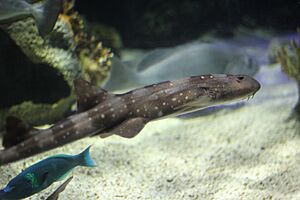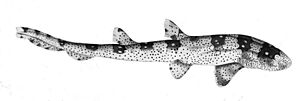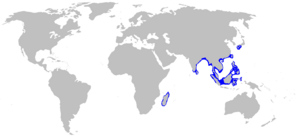Whitespotted bamboo shark facts for kids
Quick facts for kids Whitespotted bamboo shark |
|
|---|---|
 |
|
 |
|
| Conservation status | |
| Scientific classification | |
| Genus: |
Chiloscyllium
|
| Species: |
plagiosum
|
 |
|
| Range of the whitespotted bamboo shark | |
| Synonyms | |
|
Chiloscyllium caeruleopunctatum Pellegrin, 1914 |
|
The whitespotted bamboo shark (Chiloscyllium plagiosum) is a type of carpet shark. These sharks are usually small. They can grow up to 93 centimetres (37 in) (about 3 feet) long. They are mostly active at night. Whitespotted bamboo sharks are not dangerous to humans. Sometimes, people keep them as pets in large home aquariums.
Contents
What Does a Whitespotted Bamboo Shark Look Like?
These sharks have special Dorsal fins. Their back fins have curved edges. Their bodies are white with purple and pink spots. They also have dark bands. This color pattern is unique in their family. It makes them easy to identify.
Their teeth are not all the same, but they are similar. Each tooth has a main point in the middle. They also have small bumps near the root. They have about 26 to 35 teeth on their upper jaw. Their lower jaw has about 21 to 32 teeth.
Bamboo sharks often rest on the ocean floor. They prop up their head and body. They do this by resting on their bent pectoral fins. These are the fins on their sides, like arms.
Where Do Whitespotted Bamboo Sharks Live?
These sharks live in the Pacific Ocean. You can find them around coral reefs. They are common near the coasts of Indonesia. Their home range stretches from Japan all the way to India. People in Madagascar and Taiwan also eat these sharks.
What Do Whitespotted Bamboo Sharks Eat?
Whitespotted bamboo sharks hunt for food at night. They eat small fish and invertebrates. Invertebrates are animals without backbones, like crabs. Their small teeth are good for grabbing or crushing prey.
When they eat soft prey, their teeth sink in. But when they bite hard prey, their teeth can pivot backward. This protects the tips of their teeth. It also lets the flat front of their teeth form a plate. This plate helps them crush hard shells, like those of crabs.
Young sharks need more carbon than adult sharks. This is especially true during wet seasons. Whitespotted bamboo sharks are good at finding food. They are benthic predators. This means they hunt for fish near the sea bottom. Other sharks, like the spadenose shark, hunt in open water.
Like most sharks, they have special sensors on their snout. These are called ampullae of Lorenzini. They help the sharks find prey hidden in sand or mud. This makes them very good at using food sources found on the ocean floor.
Life Cycle and Reproduction
Whitespotted bamboo sharks lay eggs. This is called oviparous. Their eggs are about five inches long. The eggs hatch after 14 or 15 weeks. The baby sharks are about 6 inches long when they hatch.
Virgin Egg-Laying (Parthenogenesis)
In 2002, something amazing happened. A female whitespotted bamboo shark laid eggs. She had not been with a male for six years. These eggs hatched three young sharks! This happened at the Belle Isle Aquarium in Detroit. This was the first time this was reported for this shark species.
Scientists have ideas about how this happened. One idea is that the female had both male and female parts. Another idea is that she could store sperm for a very long time. The most likely idea is parthenogenesis. This is when an egg develops without being fertilized by sperm. The baby sharks born this way were able to have their own babies later, without a male.
Albino Sharks
Being an albino is very rare for sharks. It means they have no color in their skin. It is estimated that only 1 in 10,000 whitespotted bamboo sharks are born albino.
Three albino whitespotted bamboo sharks have hatched at SeaWorld of Orlando. The Downtown Aquarium in Denver, Colorado, has had albino whitespotted bamboo sharks hatch every year since 2007. Some of these special sharks are on display there.
Whitespotted Bamboo Sharks as Pets
These sharks are popular pets for home aquariums. This is because they are small. They also like to stay on the bottom of the tank. They eat and breed easily when kept by humans. You can buy them from many places.
Adult sharks need a very large tank. It should be at least 180 gallons, or even bigger. Pet sharks can eat pieces of squid, shrimp, clams, scallops, and marine fish. They can also eat live ghost shrimp.
See also
- List of sharks
- Carpet shark


